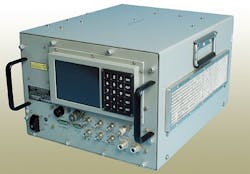BAE to provide Navy shipboard IFF interrogators to identify friendly and enemy aircraft
PATUXENT RIVER NAS, Md., 27 April 2015. U.S. Navy aviation experts are asking BAE Systems to build identification-friend-or-foe (IFF) interrogators for surface ships and land installations to help identify friendly and potentially hostile aircraft.
Officials of the Naval Air Systems Command at Patuxent River Naval Air Station, Md., announced an $8.5 million contract modification to the BAE Systems Electronic Systems segment in Greenlawn, N.Y., to provide 22 AN/UPX-41(C) digital interrogators for ships and land sites.For this order 14 are for the Navy and eight are for the government of Japan.
A digital IFF interrogator is related to shipboard air traffic control equipment. It looks at signals from the transponders of nearby aircraft to identify them on air traffic control radar, and to determine if the aircraft are friendly or potential threats.
This contract week also includes 57 Mode 5 IFF field change kits -- 45 for the Navy, and 12 for the government of Japan. These field change kits help upgrade fielded AN/UPX-41 interrogators with Mode 5 transponder capability. Mode 5 is a military feature that reads cryptographically secured transponder signals from aircraft, and helps sort out friendlies from potential enemies.
The AN/UPX-41(C) digital IFF interrogator is the U.S. Navy’s standard mode 5 level 1 and level 2 interrogator. The U.S. Marine Corps and Air Force also use if for several applications. The interrogator handles Mark XII and Mark XIIA IFF processing, including mode 5, with growth to mode S.
Related: First Thales identification friend or foe interrogator certified in United States
The unit conforms to U.S. Department of Defense (DOD), NATO, International Civil Aviation Organization (ICAO), and U.S. FAA requirements. Its design represents an upgrade to the AN/UPX-37, which replaces all AN/UPX-27 IFF interrogators in the fleet, BAE Systems officials say.
The AN/UPX-41(C) modular and digital architecture enables users to customize different configurations, and to optimize the unit for applications such as air defense, weapon systems, air traffic control, and range instrumentation.
The unit can provide digital target reports in addition to wideband video for subsequent passive and active decoding. The digital interrogator also provides amplitude monopulse for enhanced azimuth accuracy, and can operate autonomously or together with a host radar.
The interrogator uses a VME backplane and circuit boards, and has embedded M4/M5 NSA-certified cryptography, built-in test (BIT), and growth for mode S and target data extractor functions. Its mean time between failures exceeds 4,000 hours, BAE Systems officials say, and the unit meets MIL-STD-461D, DoDAIMS 03-1000A, and STANAG 4193.
Related: Embraer selects Thales identification friend or foe systems for military aircraft upgrades
The AN/UPX-41(C) can interrogate the transponders of aircraft as far away as 300 miles, and can interrogate as many as 1,000 aircraft per scan and 100 aircraft in each search beam. The unit measures 14.75 by 10.56 by 18 inches, and weighs as much as 80 pounds.
It operates in temperatures from -28 to 65 degrees Celsius, and resists the effects of salt fog, humidity, and electromagnetic interference.
On this contract modification, BAE Systems will do the work in Greenlawn, N.Y., and should be finished by December 2016. For more information contact BAE Systems Electronic Systems online at www.baesystems.com, or Naval Air Systems Command at www.navair.navy.mil.

John Keller | Editor-in-Chief
John Keller is the Editor-in-Chief, Military & Aerospace Electronics Magazine--provides extensive coverage and analysis of enabling electronics and optoelectronic technologies in military, space and commercial aviation applications. John has been a member of the Military & Aerospace Electronics staff since 1989 and chief editor since 1995.

